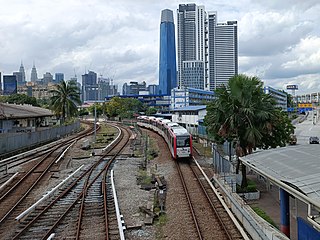CBTC mostly refers to Communications-based train control. It can also refer to:
- Confederação Brasileira de Trabalhadores Cristãos, a trade union in Brazil
- CBTC-FM, a rebroadcaster of CBYG-FM
CBTC mostly refers to Communications-based train control. It can also refer to:
Will may refer to:

The Copenhagen S-train, the S-train of Copenhagen, Denmark is a key part of public transport in the city. It is a hybrid urban-suburban rail serving most of the Copenhagen urban area, and is analogous to S-Bahn systems of Berlin, Vienna and Hamburg. The trains connect the Copenhagen inner city with Hillerød, Klampenborg, Frederikssund, Farum, Høje Taastrup and Køge. There are 170 km of double track with 86 S-train stations, of which eight are in neighbouring towns outside greater Copenhagen.
Classic FM may refer to a number classical music radio stations, including:
The IND Culver Line is a rapid transit line of the B Division of the New York City Subway, extending from Downtown Brooklyn south to Coney Island, Brooklyn, New York City, United States. The local tracks of the Culver Line are served by the F service, as well as the G between Bergen Street and Church Avenue. The express tracks north of Church Avenue are used by the <F> train during rush hours in the peak direction. The peak-direction express track between Ditmas Avenue and Avenue X has not seen regular service since 1987.

The F and <F> Queens Boulevard Express/Sixth Avenue Local are two rapid transit services in the B Division of the New York City Subway. Their route bullets are colored orange, since they use and are part of the IND Sixth Avenue Line in Manhattan.
Capital FM may refer to:

Most trains on the New York City Subway are manually operated. As of 2022, the system currently uses Automatic Block Signaling, with fixed wayside signals and automatic train stops. Many portions of the signaling system were installed between the 1930s and 1960s. Because of the age of the subway system, many replacement parts are unavailable from signaling suppliers and must be custom built for the New York City Transit Authority, which operates the subway. Additionally, some subway lines have reached their train capacity limits and cannot operate extra trains in the current system.
The Toronto subway uses a variety of signalling systems on its lines, consisting of a combination of fixed block signalling and moving block signalling technologies.
The City of Birmingham Tramways Company Ltd operated trams in Birmingham, England, from 1896 until 1911.
SelTrac is a digital railway signalling technology used to automatically control the movements of rail vehicles. It was the first fully automatic moving-block signalling system to be commercially implemented.
With or WITH may refer to:
WPRS may refer to:
Transmission balise-locomotive (TBL) is a train protection system used in Belgium and on Hong Kong's East Rail line.

The R188 is a class of new technology (NTT) New York City Subway cars built by Kawasaki Heavy Industries for the A Division. The fleet entered service in 2013, displacing the 1980s-era R62A cars that operated on the 7 and <7> services, in conjunction with the automation of the IRT Flushing Line's signal system with communications-based train control (CBTC). The R188 order also expanded the 7's fleet as part of the 7 Subway Extension, which opened in 2015.

The LRT Ampang Line and the LRT Sri Petaling Line are medium-capacity light rapid transit (LRT) lines in the Klang Valley, Malaysia. The combined network comprises 45.1 kilometres of tracks with 36 stations and was the first railway in Malaysia to use standard-gauge track and semi-automated trains. It is operated as part of the RapidKL system by Rapid Rail, a subsidiary of Prasarana Malaysia.

Communications-based train control (CBTC) is a railway signaling system that uses telecommunications between the train and track equipment for traffic management and infrastructure control. CBTC allows a train's position to be known more accurately than with traditional signaling systems. This makes railway traffic management safer and more efficient. Metros are able to reduce headways while maintaining or even improving safety.
CITYFLO 650 signalling is a CBTC system designed by Bombardier Transportation. It makes use of bi-directional radio communication between trains and wayside equipment, as well as true moving block technology, to control train operation. Trains report their position via radio, and a wayside signalling system provides movement authorities to the trains via a radio link.

The Hitachi small-type monorail is a straddle-type monorail built by Hitachi Rail for the use on the Sentosa Express. These trains are part of Hitachi Monorail line of ALWEG-based monorail. The trains were part of a project to replace Sentosa's previous aging monorail system. The trains are fully air-conditioned.

The Joo Koon rail accident, or sometimes referred to as the Joo Koon train collision, was an accident which happened on 15 November 2017, when a C151A train travelling at 16 kilometres per hour (9.9 mph) rear-ended a stationary C151A train at Joo Koon station on the East West MRT line, resulting in 38 injuries. The stationary train was in the process of being detrained due to a train fault. Both trains were operating under the recently installed Thales SelTrac CBTC signalling system at time of incident, and the Minister of Transport Khaw Boon Wan expressed that he was "disturbed" by an initial finding that "critical safety software" was inadvertently removed from the stationary train, possibly due to a malfunctioning signalling circuit, which led to the accident. This incident is the second train collision in Singapore MRT's history, after the Clementi rail accident.
KQED may refer to: